Early 1920s MARCUS GARVEY Civil Rights Black Power Pan African Protest Cause Pin


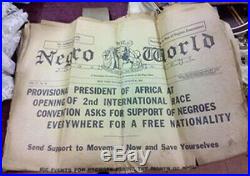
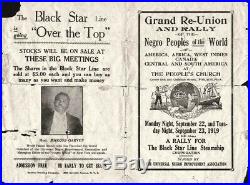

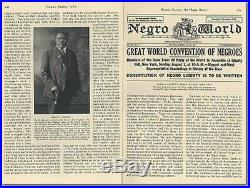
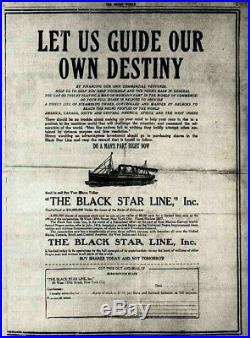
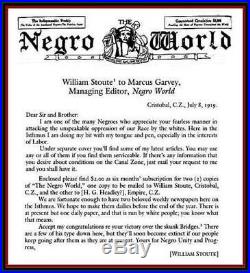
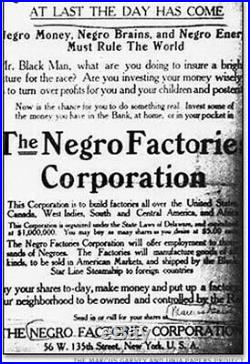

OFFERED FOR SALE IS THIS 1 1/4 INCH CELLULOID PINBACK BUTTON IN WHAT I BELIEVE TO BE REALLY NICE SHAPE. HOWEVER, THAT IS JUST MY OPINION.
SEE PHOTOS FOR CONDITION, AND YOU BE THE JUDGE. NOTE: The maker is identified on the curl as: Phila Badge Co. GUARANTEED AUTHENTIC AND ORIGINAL AS DESCRIBED.Check out my other Political and Social Protest and Cause items! The pin has a photograph of Garvey and reads: PROVISIONAL PRESIDENT OF AFRICA HON.
Only the pin is for sale, the images of paper items are for informational purposes only and are not included with the pin. (1887 1940) was a Jamaican political leader, publisher, journalist, entrepreneur, and orator.
After corresponding with Booker T. Arriving on 23 March 1916. He intended to make a lecture tour and to raise funds to establish a school in Jamaica modeled after Washington's Institute.
Garvey visited Tuskegee, and afterward, visited with a number of black leaders. After moving to New York, he found work as a printer by day. At night he would speak on street corners, much as he did in London's Hyde Park. Garvey thought there was a leadership vacuum among African Americans.On 9 May 1916, he held his first public lecture in New York City at St Mark's Church in-the-Bowery and undertook a 38-state speaking tour. The next year in May 1917, Garvey and thirteen others formed the first UNIA division outside Jamaica.
They began advancing ideas to promote social, political, and economic freedom for black people. On 2 July, 1917 the East St. On 8 July, Garvey delivered an address, entitled The Conspiracy of the East St.
Louis Riots , at Lafayette Hall in Harlem. During the speech, he declared the riot was "one of the bloodiest outrages against mankind", condemning America's claims to represent democracy when black people were victimized "for no other reason than they are black people seeking an industrial chance in a country that they have labored for three hundred years to make great".
It is a time to lift one's voice against the savagery of a people who claim to be the dispensers of democracy. " Garvey worked to develop a program to improve the conditions of ethnic Africans "at home and abroad under UNIA auspices. Garvey worked as an editor without pay until November 1920. By June 1919, the membership of the organization had grown to over two million , according to its records.
On 27 June 1919, the UNIA set up its first business , incorporating the Black Star Line of Delaware , with Garvey as President. The Black Star Line promoted the return of the African Diaspora to their ancestral lands. Convinced that black people should have a permanent homeland in Africa, Garvey sought to develop Liberia.
It had been founded by the American Colonization Society in the 19th century as a colony for free blacks from the United States. Garvey launched the Liberia program in 1920 , intended to build colleges, industrial plants, and railroads as part of an industrial base from which to operate. He abandoned the program in the mid-1920s after much opposition from European powers with interests in Liberia. By August 1920, the UNIA claimed four million members.
That month, the International Convention of the UNIA was held. With delegates from all over the world attending, 25,000 people filled Madison Square Garden on 1 August 1920 to hear Garvey speak. Garvey attracted more than 50,000 people to the event and in his cause.
He planned to develop the businesses to manufacture every marketable commodity in every big U. Industrial center, as well as in Central America, the West Indies, and Africa. Related endeavors included a grocery chain, restaurant, publishing house, and other businesses. This underground pinback button pin or badge relates to the Hippie (or Hippy) Counterculture Movement of the psychedelic Sixties (1960's) and Seventies (1970's). That movement included such themes and topics as peace, protest, civil rights, radical, socialist, communist, anarchist, union labor strikes, drugs, marijuana, pot, weed, lsd, acid, sds, iww, anti draft, anti war, anti rotc, welfare rights, poverty, equal rights, integration, gay, women's rights, black panthers, black power, left wing, liberal, etc. Progressive political movement and is guaranteed to be genuine as described.The Deacons emerged as one of the first visible self-defense forces in the South and as such represented a new face of the civil rights. Traditional civil rights organizations remained silent on them or repudiated their activities. They were effective however in providing protection for local African Americans who sought to register to vote and for white and black civil rights workers in the area. The Deacons, for example, provided security for the 1966 March Against Fear from Memphis to Jackson, Mississippi.
Moreover their presence in Southeastern Louisiana meant that the Klan would no longer be able to intimidate and terrorize local African Americans without challenge. The strategy and methods that the Deacons employed attracted the attention and concern of the Federal Bureau of Investigation (FBI), which authorized an investigation into the groups activities. The investigation stalled, however, when more influential black power organizations such as US and the Black Panther Party. Emerged after the 1965 Watts Riot. With public attention, and the attention of the FBI focused elsewhere, the Deacons lost most of their notoriety and slowly declined in influence.By 1968 they were all but extinct. In 2003 the activities of the Deacons was the subject of a 2003, Deacons for Defense.
On July 10, 1964, a group of African American men in Jonesboro, Louisiana. Led by Earnest Chilly Willy Thomas and Frederick Douglas Kirkpatrick founded the group known as The Deacons for Defense and Justice to protect members of the Congress of Racial Equality (CORE).Against Ku Klux Klan violence. Most of the Deacons were veterans of World War II. The Jonesboro chapter organized its first affiliate chapter in nearby Bogalusa, Louisiana led by Charles Sims, A. Eventually they organized a third chapter in Louisiana. The Deacons tense confrontation with the Klan in Bogalusa was crucial in forcing the federal government to intervene on behalf of the local African American community.
The national attention they garnered also persuaded state and national officials to initiate efforts to neutralize the Klan in that area of the Deep South. THIS IS MY HOBBY AND IS NOT A BUSINESS. IF YOU ARE NOT A MEMBER, YOU SHOULD CONSIDER JOINING. IT IS A GREAT ORGANIZATION!
THANK YOU FOR YOUR INTEREST. The item "Early 1920s MARCUS GARVEY Civil Rights Black Power Pan African Protest Cause Pin" is in sale since Tuesday, August 20, 2019. This item is in the category "Collectibles\Historical Memorabilia\Political\US\Peace & Anti-War Movements".
The seller is "causenik" and is located in Ojai, California. This item can be shipped worldwide.